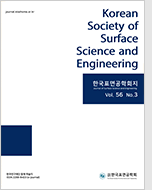
- Past Issues
- e-Submission
-

2021 Impact Factor 1.766
5-Year Impact Factor 1.674
Editorial Office
- +82-2-563-0935
- +82-2-558-2230
- submission@kssse.or.kr
- https://www.kssse.or.kr/

2021 Impact Factor 1.766
5-Year Impact Factor 1.674
The Korean Society of Surface Science and Engineering 2023;56(1):94-103. Published online: Feb, 28, 2023
DOI : 10.5695/JSSE.2023.56.1.94
The effects of carburizing pressure and gas ratio on vacuum carburizing properties (uniformity and surface characteristics) have been studied through the analyses of carbon concentration, hardness, surface color, surface roughness and type of carbon bonding. AISI 4115 steel specimens were carburized with various pressures (1, 5, and 10 Torr) at different locations (P1, P2, P3, P4, P5, and P6) inside a furnace held at 950 ℃. Since the carburizing pressure represents the density of the carburizing gas, it plays an important role in improving the carburizing uniformity according to locations in the furnace. As the carburizing pressure increased, the carburizing uniformity according to the sample location was improved, but the surface of the carburized specimen was discolored due to the residual acetylene gas, which does not contribute to the carburizing reaction. Therefore, the carburizing uniformity and surface discoloration have been improved by injecting acetylene gas (carburizing gas) and nitrogen gas (non-reactive gas) in a specific ratio.
Keywords Vacuum carburizing; Pressure; Uniformity; Acetylene; Nitrogen.